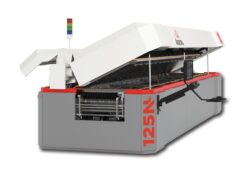Industry 4.0, the Fourth Industrial Revolution or the Industrial Internet of Things (IIoT). Regardless of the phrase used to describe digitalization in manufacturing, there’s no denying that a shift has already taken place. But, is the age of industrial buzzwords coming to a grinding halt? Stefan Reuther, Chief Sales Officer at COPA-DATA, gives his three predictions for industrial automation in 2019 — no buzzwords included.
‘Industry 4.0’ in practice
Manufacturers have long felt the pressure to invest in new technologies. In the so-called age of Industry 4.0, this pressure has been heightened by an influx of products and initiatives, all claiming to help manufacturers digitize their operations. Unfortunately, some of these schemes are nothing more than a waste of money.
Don’t get me wrong, there is certainly value in investing in technology to enable digitalization in factories’ practices. However, rushed approaches have led to some manufacturers making haphazard investments. For example, some have delegated digitalization to third parties and as a result, are not in charge of their own automation.
Before embarking on a digitalization scheme, manufacturers should first examine which technology is practical to their facility. A good place to begin is to listen to the people on the factory floor. Understanding how technology can practically help workers can ensure that investments are pragmatic.
Another thing to consider is simplicity, by reducing complexity of processes and gaining a clearer overview and full control. Manufacturers should choose technology that is easy to understand, implement and scale up in the future. Looking forward to 2019, digitalization should be approached in a more practical manner — a steady, incremental transformation is better than a failed one.
Less data hoarding, more data use
Software is another area that has been constantly hallmarked as a method to speed up manufacturing digitalization. However, before investing in software for data collection, manufacturers should begin 2019 by implementing a coherent data strategy.
Rather than simply collecting and storing data, manufacturers must identify the results that they want to achieve and decide how data can help them to meet these business objectives.
Consider this as an example. Let’s say a manufacturer wants to improve return on investment (ROI) in the facility by reducing the amount of materials wasted from production. To identify areas of improvement, manufacturers would need to collect production data and compare this with data from Enterprise Resource Planning (ERP).
Without a pre-determined strategy like this, manufacturers run the risk of simply collecting and storing hordes of data. There’s no value in data if it is left to gather dust. Over the next twelve months, we hope to see data strategies become an integral part of manufacturing. That said, data strategies are only comprehensible when using the correct software.
The software evolution
Recent years have seen a shift in the amount of investment manufacturers assign to software. Traditionally, hardware would have received the largest bulk of cash, but this is beginning to change — particularly as more advanced software platforms emerge.
Software for manufacturing facilities is no longer limited to Manufacturing Execution Systems (MES) and Supervisory Control and Data Acquisition (SCADA). The realm of industrial software is experiencing a convergence of IT and operational technologies (OT), giving birth to new platforms which integrate a plethora of different areas — including enterprise data from the corporate level, through to field and process level automation.
While this may sound more complicated than traditional systems, these platforms often boast better design, visualization, calculation logic and ergonomics than their predecessors. This makes the operation of systems safer, simpler and more transparent.
I might have promised no buzzwords, but software is the driver of what is so commonly referred to as Industry 4.0. As a result, it is no surprise that we are likely to see increased investment in integrated platforms like these over the next twelve months.
The age of conceptualizing the possibilities of manufacturing digitalization is over. During the next twelve months, the products and initiatives hailed as ways to transform manufacturing facilities will finally be put to practical use.
About COPA-DATA
COPA-DATA is the manufacturer of the zenon® software platform, used in the manufacturing and energy industries for the automated control, monitoring, and optimization of machines, equipment, and power supplies. Founded by Thomas Punzenberger in 1987 and headquartered in Salzburg, Austria, the independent, family-owned company employs approximately 260 workers around the globe. The distribution of software on an international scale is made possible through the company’s eleven subsidiaries and numerous distributors. In addition, more than 240 certified partner companies ensure efficient software implementation for end users in the food & beverage, energy & infrastructure, automotive, and pharmaceutical industries. In 2017, COPA-DATA generated turnover of EUR 37 million.
About zenon
zenon is a software system from COPA-DATA for industrial automation and the energy industry. Machines and equipment are controlled, monitored and optimized. zenon’s particular strength is open and reliable communication in heterogeneous production facilities. Open interfaces and over 300 native drivers and communication protocols support the horizontal and vertical integration. This allows for continuous implementation of the Industrial IoT and the Smart Factory. Projects with zenon are highly scalable.
zenon is ergonomic, both for the engineer and for the end user. The engineering environment is flexible and can be used for a wide range of applications. The principle of “setting parameters instead of programming” helps engineers to configure projects quickly and without errors. Complex functions for comprehensive projects are supplied out-of-the-box to create intuitive and robust applications. Users can thereby contribute to increased flexibility and efficiency with zenon.










